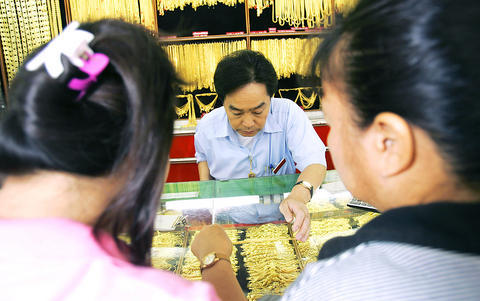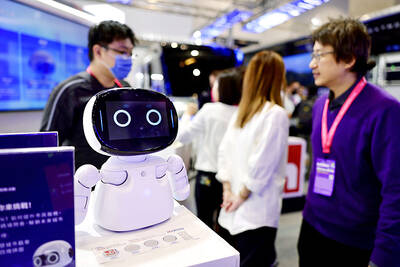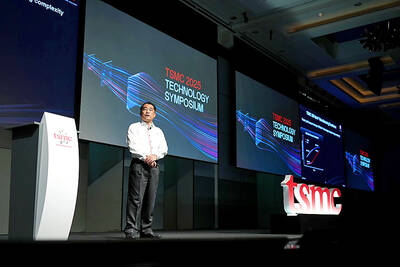Gold was little changed in Asia yesterday after breaching US$1,000 for the first time as investors turned cautious, gauging the extent of a US economic slowdown and prospects for a prolonged global credit crisis.
Gold futures climbed as high as US$1,000.45 an ounce on Thursday as mounting credit-market losses spurred demand for bullion as a haven from the sagging dollar and equities. Gold is up 37 percent since the US Federal Reserve began cutting borrowing costs in September, sending the dollar tumbling.
"Gold strength has been mainly driven by the weak dollar, strong crude and increasing fear of recession," Stephan Schlatter, executive director for metals markets in Asia at UBS AG, said from Singapore yesterday by e-mail.

PHOTO: AP
"Assuming that the situation will not change over the next few weeks there is still a high probability that gold will show continuing strength," he said.
Gold for immediate delivery was little changed at US$996.49 an ounce at 2:49pm in Singapore. Silver gained 0.9 percent to US$20.69 an ounce, compared with US$21.23 on March 6, the highest since 1980.
The US Federal Open Market Committee's next regular meeting is on Tuesday. Traders expect the Fed to lower its benchmark rate by 0.75 percentage point to 2.25 percent based on futures prices.
"Gold might still go higher to US$1,100 or succumb to some profit-taking, depending on the extent of the interest-rate cut and whether the subprime crisis has come to an end," Ng Cheng Thye, head of precious metals markets at Standard Bank Asia, said by phone from Singapore.
Gold futures for April delivery gained US$4.60, or 0.5 percent, to US$998.40 an ounce on the Comex division of the New York Mercantile Exchange. The price reached US$1,001.50 on Thursday, the highest ever for a most-active contract.
Gold's all-time inflation adjusted record is US$2,284 on Jan. 21, 1980, according to a calculator on the Web site of the Federal Reserve Bank of Minneapolis.
The metal jumped 31 percent last year as the dollar fell 9.5 percent against the euro.
The dollar headed for a fifth straight week of declines against the euro and the fourth week of losses versus the yen.
The US currency traded at US$1.5615 per euro at 2:41pm in Singapore, after touching US$1.5645 per euro on Thursday, the weakest since the European currency's debut in 1999. It traded at ?100.35, after touching ?99.77 on Thursday, the lowest since 1995.
Rising prices for precious metals such as gold and silver may deter buying from the end users such as jewelers, Ng said.
"Precious metals, especially silver, see big discounts in the spot market which is a sign of weak physical demand," he said.
The recent gains were "on the back of speculation only," Schlatter said.
"When attacking again the magic US$1,000 hurdle, the risk of seeing profit-taking on speculative positions is increasing," he said.
Gold demand in the January-March quarter will decline from a year earlier as record prices curb purchases, the World Gold Council said earlier this week.

DEMOGRAPHICS: Robotics is the most promising answer to looming labor woes, the long-term care system and national contingency response, an official said Taiwan is to launch a five-year plan to boost the robotics industry in a bid to address labor shortages stemming from a declining and aging population, the Executive Yuan said yesterday. The government approved the initiative, dubbed the Smart Robotics Industry Promotion Plan, via executive order, senior officials told a post-Cabinet meeting news conference in Taipei. Taiwan’s population decline would strain the economy and the nation’s ability to care for vulnerable and elderly people, said Peter Hong (洪樂文), who heads the National Science and Technology Council’s (NSTC) Department of Engineering and Technologies. Projections show that the proportion of Taiwanese 65 or older would

Nvidia Corp yesterday unveiled its new high-speed interconnect technology, NVLink Fusion, with Taiwanese application-specific IC (ASIC) designers Alchip Technologies Ltd (世芯) and MediaTek Inc (聯發科) among the first to adopt the technology to help build semi-custom artificial intelligence (AI) infrastructure for hyperscalers. Nvidia has opened its technology to outside users, as hyperscalers and cloud service providers are building their own cost-effective AI chips, or accelerators, used in AI servers by leveraging ASIC firms’ designing capabilities to reduce their dependence on Nvidia. Previously, NVLink technology was only available for Nvidia’s own AI platform. “NVLink Fusion opens Nvidia’s AI platform and rich ecosystem for

Taiwan Semiconductor Manufacturing Co (TSMC, 台積電) yesterday said it is building nine new advanced wafer manufacturing and packaging factories this year, accelerating its expansion amid strong demand for high-performance computing (HPC) and artificial intelligence (AI) applications. The chipmaker built on average five factories per year from 2021 to last year and three from 2017 to 2020, TSMC vice president of advanced technology and mask engineering T.S. Chang (張宗生) said at the company’s annual technology symposium in Hsinchu City. “We are quickening our pace even faster in 2025. We plan to build nine new factories, including eight wafer fabrication plants and one advanced

‘WORLD’S LOSS’: Taiwan’s exclusion robs the world of the benefits it could get from one of the foremost practitioners of disease prevention and public health, Minister Chiu said Taiwan should be allowed to join the World Health Assembly (WHA) as an irreplaceable contributor to global health and disease prevention efforts, Minister of Foreign Affairs Lin Chia-lung (林佳龍) said yesterday. He made the comment at a news conference in Taipei, hours before a Taiwanese delegation was to depart for Geneva, Switzerland, seeking to meet with foreign representatives for a bilateral meeting on the sidelines of the WHA, the WHO’s annual decisionmaking meeting, which would be held from Monday next week to May 27. As of yesterday, Taiwan had yet to receive an invitation. Taiwan has much to offer to the international community’s